Large, high severity fires are becoming more common, and the warming, drying climate is making conditions ideal for these devastating fires. Human caused wildfires are a big part of the wildfire threat, that research shows we can reduce with targeted fire prevention efforts.
Reducing human-caused ignitions is critical to creating communities that are adapted to wildfire. People start wildfires with their vehicles, cigarette butts, campfires, fireworks, debris burning, powerlines, arson, and other activities. Since there are many ways humans start wildfires and prevention takes numerous forms, reducing human wildfire ignitions is a complex problem that spans geographical and jurisdictional boundaries. The Fire Adapted Communities Network, including FACNM, empowers individuals to work across jurisdictional and geographical boundaries, providing a path forward for spreading awareness of wildfire risk and reducing human-caused ignitions at a landscape-scale.
Some recent publications on increasing wildfire awareness and reducing human-caused ignitions may be helpful in highlighting this aspect of FACNM. These reports attempt to amplify the need for greater investment in fire prevention awareness at the national level while identifying opportunities for partnership to support fire prevention at the local level.
Fire Prevention Awareness in 2018
The 2018 report, “Increasing Wildfire Awareness and Reducing Human-Caused Ignitions in Northern New Mexico.”
The Guild’s 2018 report, titled “Increasing Wildfire Awareness and Reducing Human Caused Ignitions in Northern New Mexico” was designed to help support wildfire prevention by identifying how people start wildfires, common locations of human-caused wildfires, existing public awareness campaigns, and current investments in public awareness of wildfire.
Key Findings of the 2018 report included:
The 2018 Fire Prevention poster that was adopted by The Santa Fe National Forest and demonstrated effectiveness at reducing abandoned campfires.
In New Mexico. human-caused wildfire accounted for half of the acres burned by wildfire since 2001.
Abandoned campfires account for 44% of the human-caused wildfires since 2001 and 37 percent of the acres burned by these fires.
Electrical power lines are a significant cause of wildfires.
More knowledge about the spatial patterns of human ignitions presents the opportunity for targeted outreach and education, which is a cost-effective way to reduce wildfire impacts.
In New Mexico 80 percent of wildfires started by campfires are within a quarter mile of a mile.
Hotspot modeling to identify areas of high arson potential can help law enforcement reduce wildfire threats.
Currently, federal agency budgets for prevention programs do not reflect their importance.
The National Prevention Program only has an annual budget of $95,000 and one full-time staff person for the whole country to help coordinate awareness efforts.
Research has shown that wildfire damages can be as much as 35 times greater than the cost of prevention education.
Public awareness campaigns, such as Smokey Bear and more recent One Less Spark, seek to change behaviors , but there is little information about their effectiveness.
The most recent investigation into the effectiveness of wildfire prevention signs was more than 40 years ago.
The 2018 report inspired a wildfire prevention poster designed to reduce human-caused ignitions by providing techniques for adequately putting out a campfire (See above). The prevention poster was adopted by the Santa Fe National Forest. Prevention officers reported that it was effective at reducing the number of abandoned campfires over peak holiday weekends like Memorial Day and The Fourth of July.
Fire Prevention Awareness in 2020
In 2020, the Guild began a follow-up report that explores federal investment in fire prevention awareness at the ranger district and forest levels. This report aims to better understand the US Forest Service’s (USFS) contribution to public awareness of wildfire risk by documenting investment in prevention programs across eight ranger districts on the Santa Fe and Coconino National Forests. Since there is no budget or line item to document this investment, data was collected through phone interviews with Fire Prevention Technicians and Fire Management Officers.
Some preliminary findings of the 2020 report include:
Compared to our spending on fire suppression, we are not investing enough as a nation in prevention given how effective it can be in reducing wildfires.
The amount of investment in fire prevention programs varies between ranger districts depending on local social and ecological conditions and between years depending on forecasted moisture availability and weather conditions during late spring, summer, and early fall.
Increased clarity about the USFS investments in prevention would help identify what is working and where increased resources are necessary.
Greater information sharing and transparency about the challenges that fire prevention programs face with human-caused ignitions will encourage cross-boundary solutions and shared stewardship of increasing awareness of wildfire risk.
There is a high level of cross-over between fire suppression resources and investment and fire prevention resources and investment making it difficult to account for staff time spent on fire prevention work.
Most of the ranger districts we interviewed lacked capacity to accomplish both suppression and prevention tasks at least some points during fire season.
Creating and sharing actionable prevention plans based on priority areas is a sensible starting point for advancing wildfire prevention.
These reports attempts to identify the current conditions of the USFS’s contribution to public awareness of wildfire risk by exploring fire prevention efforts at the national level and within local ranger districts. We hope to amplify the importance of this investment to national legislation through the collective voice of FACNM and the national Fire Adapted Communities Learning Network while finding creative solutions through partnerships and collaboration at local levels.
If you are interested in contributing to the 2020 report on fire prevention awareness, or would like to learn more, please contact gabe@forestguild.org. This work can only benefit through the input of many perspectives and we encourage this feedback through FACNM.
This work is made possible through a partnership between The Forest Stewards Guild and The Forest Trust.



